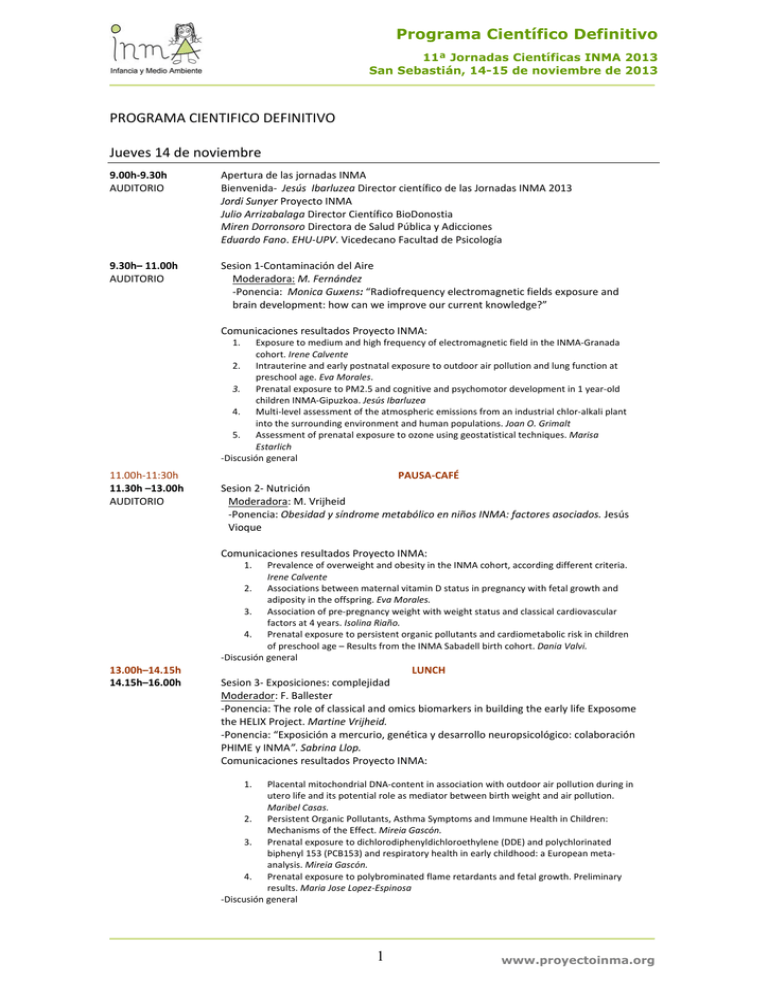Programa Científico Definitivo PROGRAMA CIENTIFICO DEFINITIVO
Anuncio

Programa Científico Definitivo 11ª Jornadas Científicas INMA 2013 San Sebastián, 14-15 de noviembre de 2013 PROGRAMA CIENTIFICO DEFINITIVO Jueves 14 de noviembre 9.00h‐9.30h AUDITORIO 9.30h– 11.00h AUDITORIO Apertura de las jornadas INMA Bienvenida‐ Jesús Ibarluzea Director científico de las Jornadas INMA 2013 Jordi Sunyer Proyecto INMA Julio Arrizabalaga Director Científico BioDonostia Miren Dorronsoro Directora de Salud Pública y Adicciones Eduardo Fano. EHU‐UPV. Vicedecano Facultad de Psicología Sesion 1‐Contaminación del Aire Moderadora: M. Fernández ‐Ponencia: Monica Guxens: “Radiofrequency electromagnetic fields exposure and brain development: how can we improve our current knowledge?” Comunicaciones resultados Proyecto INMA: 1. Exposure to medium and high frequency of electromagnetic field in the INMA‐Granada cohort. Irene Calvente 2. Intrauterine and early postnatal exposure to outdoor air pollution and lung function at preschool age. Eva Morales. 3. Prenatal exposure to PM2.5 and cognitive and psychomotor development in 1 year‐old children INMA‐Gipuzkoa. Jesús Ibarluzea 4. Multi‐level assessment of the atmospheric emissions from an industrial chlor‐alkali plant into the surrounding environment and human populations. Joan O. Grimalt 5. Assessment of prenatal exposure to ozone using geostatistical techniques. Marisa Estarlich ‐Discusión general 11.00h‐11:30h 11.30h –13.00h AUDITORIO PAUSA‐CAFÉ Sesion 2‐ Nutrición Moderadora: M. Vrijheid ‐Ponencia: Obesidad y síndrome metabólico en niños INMA: factores asociados. Jesús Vioque Comunicaciones resultados Proyecto INMA: 1. Prevalence of overweight and obesity in the INMA cohort, according different criteria. Irene Calvente 2. Associations between maternal vitamin D status in pregnancy with fetal growth and adiposity in the offspring. Eva Morales. 3. Association of pre‐pregnancy weight with weight status and classical cardiovascular factors at 4 years. Isolina Riaño. 4. Prenatal exposure to persistent organic pollutants and cardiometabolic risk in children of preschool age – Results from the INMA Sabadell birth cohort. Dania Valvi. ‐Discusión general 13.00h–14.15h 14.15h–16.00h LUNCH Sesion 3‐ Exposiciones: complejidad Moderador: F. Ballester ‐Ponencia: The role of classical and omics biomarkers in building the early life Exposome the HELIX Project. Martine Vrijheid. ‐Ponencia: “Exposición a mercurio, genética y desarrollo neuropsicológico: colaboración PHIME y INMA”. Sabrina Llop. Comunicaciones resultados Proyecto INMA: 1. Placental mitochondrial DNA‐content in association with outdoor air pollution during in utero life and its potential role as mediator between birth weight and air pollution. Maribel Casas. 2. Persistent Organic Pollutants, Asthma Symptoms and Immune Health in Children: Mechanisms of the Effect. Mireia Gascón. 3. Prenatal exposure to dichlorodiphenyldichloroethylene (DDE) and polychlorinated biphenyl 153 (PCB153) and respiratory health in early childhood: a European meta‐ analysis. Mireia Gascón. 4. Prenatal exposure to polybrominated flame retardants and fetal growth. Preliminary results. Maria Jose Lopez‐Espinosa ‐Discusión general 1 www.proyectoinma.org Programa Científico Definitivo 11ª Jornadas Científicas INMA 2013 San Sebastián, 14-15 de noviembre de 2013 16.00h ‐16.30h SALA EXPOSICIONES 16.30h‐18.00 AUDITORIO PAUSA‐CAFÉ Sesión 4‐ Desarrollo Neuroconductual Moderador: J. Julvez ‐Ponencia: Psychological development in Infancy: the developmental meaning of Theory of Mind. Enrique Arranz ‐Ponencia Propuesta de Protocolo de la fase de 9 años. Presentación del protocolo del próximo seguimiento en la cohorte INMA‐Sabadell.Maribel Casas Comunicaciones resultados Proyecto INMA: 1. Assessment of Theory of Mind During Early Childhood. Evaluación de la Teoría de la Mente en la primera infancia. Manuel Sánchez de Miguel. 2. Social causation effect in neuropsychological development at 26 month. Aritz Aranbarri. 3. Non‐persistent pesticide levels and child neuropsychological development: preliminary results in INMA‐DENAMIC. Marisa Rebagliato. 4. Total Effective Xenoestrogen Burden and early neuropsychological development in Children from INMA cohort. Nadia Vilhaur. 5. A cohort study on full breastfeeding and child neuropsychological development: the role of maternal social, psychological, and nutritional factors. Jordi Julvez. ‐Discusión general Viernes 15 de noviembre 8.30h–10.00h AUDITORIO Avances en el estudio Neuropsicobiológico en la infancia: Moderardor: Enrique Arranz ‐Ponencia: Neuroimaging in childhood. Kepa Paz‐Alonso (BCBL) ‐Ponencia: Neuropsychological Assessment in Childhood. Marie Lallier (BCBL). ‐Ponencia: Marcadores Psicobiológicos en la infancia.Aitziber Azurmendi (UPV/EHU) ‐Discusión general 10.00h–11.15h AULA 1 AULA 2 AULA 3 AULA 4 11.15h ‐11.45h SALA EXPOSICIONES 11.45h–13.00h AULA 1 AULA 2 AULA 3 AULA 4 13.00h– 14.30h AUDITORIO 14.30h‐15.00h SALA EXPOSICIONES 1. Grupo de trabajo de Desarrollo Neuroconductual Responsables: J Julvez/J Ibarluzea 2. Grupo de trabajo de Contaminación del Aire Responsable: M Estarlich/C Iñiguez 3. Grupo de trabajo de Obesidad Responsable: M Vrijheid 4.Grupo de trabajo de Genética Responsable: J Sunyer CAFÉ+ FOTO 1. Grupo de trabajo de Nutrición Responsable: J Vioque 2. Grupo de trabajo de Metales, Pesticidas y Nuevas Exposiciones Responsable: S Llop/MJ López 3. Grupo de trabajo de Análisis de Datos Conjuntos Responsable: L Cirugeda/M Murcia 4. Grupo de trabajo de Trabajo de Campo‐Protocolo 9 años Responsable: J Julvez/M Casas Conclusiones de los grupos de trabajo (cada responsable) Conclusiones generales y cierre de jornada. Jordi Sunyer LUNCH 2 www.proyectoinma.org